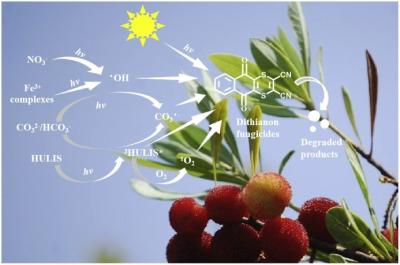Prof. Chengjun Wang’s article entitled “Enhanced photodegradation of applied dithianon fungicides on plant leaves by dissolved substances in atmosphere under simulated sunlight” was published in Chemosphere. Master student Xiaoyu Jiao is the first author of the article.
Abstract
Photolysis of pesticides has been widely investigated for evaluating their environmental behavior and agricultural effectiveness after crop spraying. However, little information about the effects of the water-soluble substances in atmosphere on photodegradation of pesticides is available. In current study, we found that photolysis of applied dithianon fungicides on real plant leaves was much faster than that in sealed stock aqueous suspensions under simulated sunlight. To simulate the natural conditions, for the first time, photodegradation of dithianon in air-saturated solutions containing typical dissolved atmospheric substances (DAS) including CO2 (HCO3−/CO32−), NO2 (NO3−), Fe3+ (Fe3+-complexes), and humic-like substances (HULIS) exposed to simulated solar irradiations were carried out in lab-scale. Fulvic acid (FA) was used as a surrogate for atmospheric HULIS in this study. The dithianon photodegradation was significantly enhanced in the presence of DAS and the photo-generated reactive species such as ·OH, 1O2, CO3·- and 3FA∗ play important roles according to the results of reactive species quenching, electron spin resonance spectroscopy, and laser flash photolysis experiments. Moreover, the photodegraded intermediates and final products of dithianon on plant leaves have been identified by HPLC-MS analysis, and its possible photodegradation pathways were proposed. This work indicated that, except for direct photolysis, indirect photosensitive degradation induced by the dissolved photo-active substances in atmosphere should be considered for evaluating the degradation of the applied pesticides on crops.

Link of the paper via:
https://www.sciencedirect.com/science/article/pii/S0045653520310006